Comparing Genetic Diversity in Three Threatened Oaks
Abstract
1. Introduction
- Assess levels of genetic diversity and differentiation in our focal species and compare them to other rare and common oak species (hypothesis: common oak species have more genetic diversity);
- Determine if genetic diversity and differentiation correlate with the relative range size of the three oak species (hypothesis: larger range size correlates to higher genetic diversity and higher genetic structure)
- Determine if genetic diversity and differentiation are correlated with demographic (e.g., population size) and/or environmental variables (hypothesis: lower genetic diversity in smaller populations; genetic diversity correlates with environmental variables);
- Quantify the amount of genetic diversity of each species that is conserved ex situ and determine whether this is correlated with features of those species (hypothesis: genetic diversity should be predicted by both the number of plants ex situ and the commonness of the species).
2. Materials and Methods
2.1. Study Species, Sampling, and Genotyping
2.2. Analysis: Basic Statistics
2.3. Influence of Environment on Genetic Diversity and Differentiation
2.4. Influence of Local Population Size
3. Results
3.1. Basic Results
3.2. Genetic Diversity and Range Size for Our Three Rare Oaks
3.3. Genetic Diversity and Range Size within Each Species
3.4. Genetic Diversity and Environment
3.5. Genetic Diversity in Ex Situ Collections
3.6. Other Observations
4. Discussion
Caveats
5. Conclusions and Conservation Implications
Author Contributions
Funding
Institutional Review Board Statement
Data Availability Statement
Acknowledgments
Conflicts of Interest
Appendix A
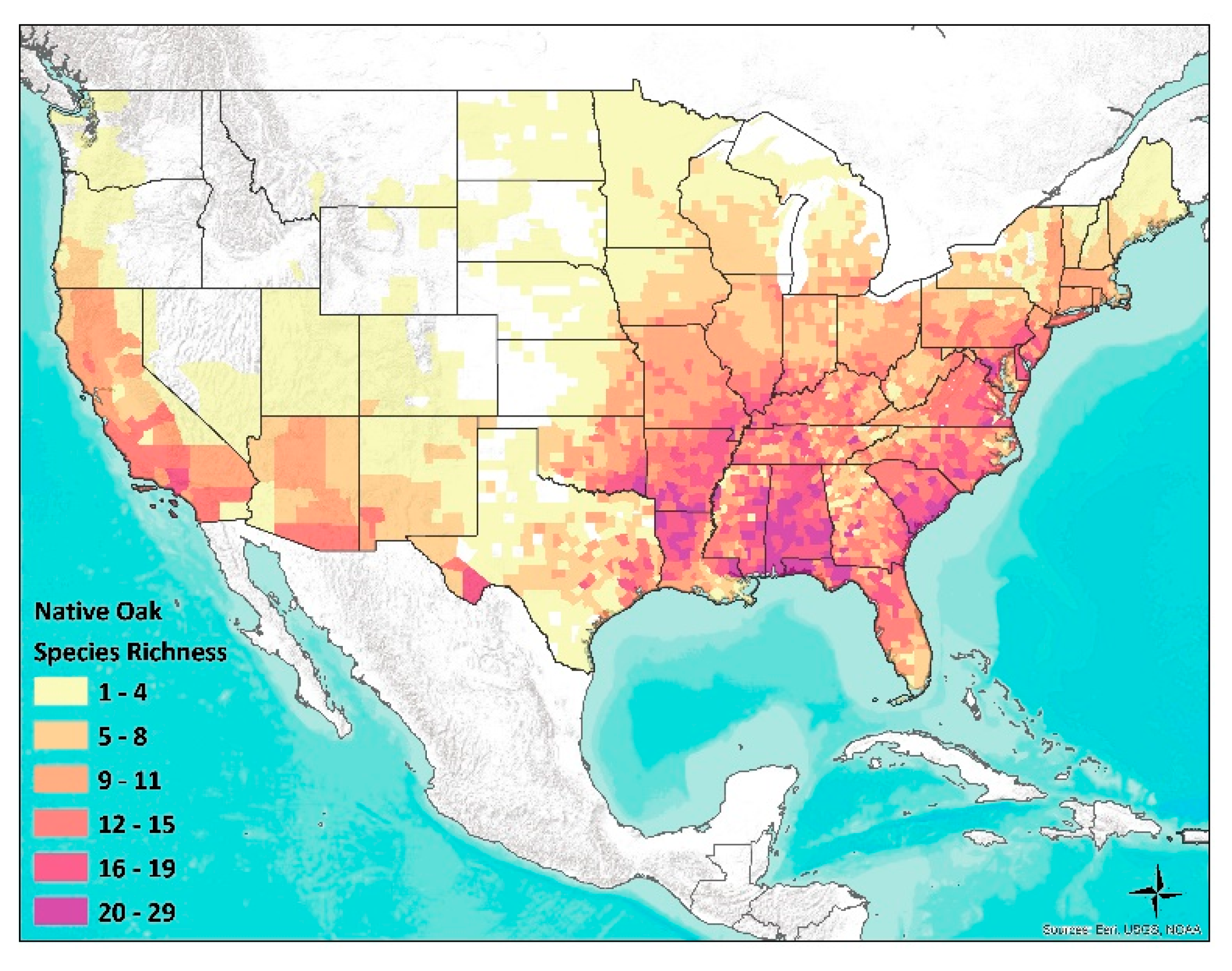
| Geographic Range | Large | Small | ||
| Habitat Specificity | Wide | Narrow | Wide | Narrow |
| Local Population Size | ||||
| Large, Dominate somewhere | ||||
| Small, non-dominant | Q. hemisphaerica Q. incana Q. laevis | Q. boyntonii Q. georgiana Q. oglethorpensis | ||
| Species | Section | IUCN Status | AOO | EOO | # of Loci | # of pops | Sample Size (N) | FST | GST | Mean Number of Alleles | AR | Ho | He | FIS | Citation |
|---|---|---|---|---|---|---|---|---|---|---|---|---|---|---|---|
| Quercus phillyraeoides | Cerris | NEN | NR | NR | 11 | 24 | 536 | 0.097 | 0.09 | 10.45 | 4.47 | 0.51 | 0.54 | 0.079 | [75] |
| Quercus georgiana | Lobatae | EN | 272 | 21,600 | 8 | 9 | 224 | 0.049 | NR | 8.03 | 7.82 | 0.72 | 0.69 | 0.019 | - |
| Quercus rubra | Lobatae | LC | NR | 4,150,115 | 10 | 23 | 980 | 0.044 | NR | NR | 5.5– 12.14 | NR | NR | NR | [76] |
| Quercus berberidifolia | Quercus | LC | NR | 250,000 | 8 | 2 | 60 | NR | NR | 18.6 | 5.72 | 0.85 | 0.88 | 0.039 | [52] |
| Quercus boyntonii | Quercus | CR | 24 | 4,157 | 9 | 7 | 238 | 0.026 | NR | 7.24 | 5.07 | 0.62 | 0.55 | 0.061 | - |
| Quercus dumosa | Quercus | EN | 620 | 12,500 | 8 | 2 | 24 | NR | NR | 11.1 | 4.9 | 0.77 | 0.8 | 0.029 | [77] |
| Quercus hinckleyi | Quercus | CR | 30 | 380 | 8 | 4 | 123 | NR | 0.03 | 13.06 | 5.15–14.73 | 0.81 | 0.85 | 0.036 | [52] |
| Quercus lobata Née | Quercus | NT | NR | 280,000 | 8 | 12 | 270 | 0.064 | NR | 8.12 | NR | 0.8 | 0.7 | -0.196 | [78] |
| Quercus macrocarpa | Quercus | LC | NR | 4056,799 | 5 | 14 | 480 | 0.027 | NR | 11.184 | NR | 0.92 | 0.86 | NR | [79,80] |
| Quercus oglethorpensis | Quercus | EN | 3000 | 130,000 | 9 | 7 | 188 | 0.062 | NR | 6.81 | 5.8 | 0.64 | 0.48 | 0.234 | - |
| Quercus pacifica | Quercus | EN | NR | 3800 | 8 | 3 | 133 | 0.233 | NR | 15.8 | 5.54 | 0.81 | 0.85 | 0.05 | [77] |
| Quercus chrysolepis | Protobalanus | LC | NR | 920,000 | 8 | 7 | 100 | NR | NR | 16.4 | 4.63 | 0.71 | 0.83 | 0.146 | [53] |
| Quercus tomentella | Protobalanus | EN | 250 | 43,500 | 8 | 6 | 345 | NR | NR | 16.3 | 3.63 | 0.56 | 0.76 | 0.262 | [53] |
| AVERAGE of previously studied species | 300 | 1,079,677 | 8 | 10 | 305 | 0.093 | 0.06 | 13.45 | 4.82 | 0.75 | 0.79 | 0.056 | |||
| AVERAGE of all species | 699 | 822,738 | 8 | 9 | 285 | 0.075 | 0.06 | 11.92 | 5.29 | 0.72 | 0.73 | 0.069 |
Appendix B
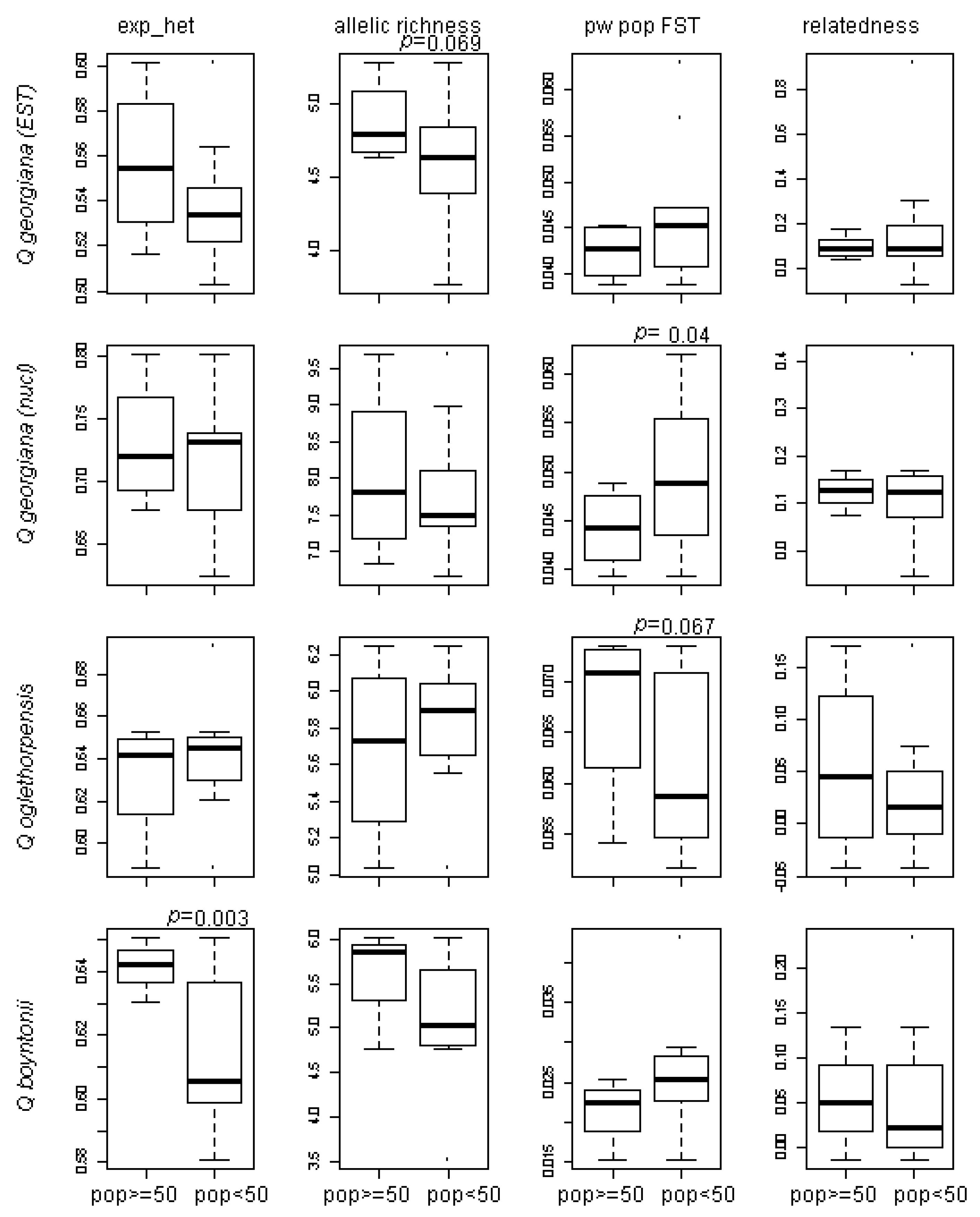
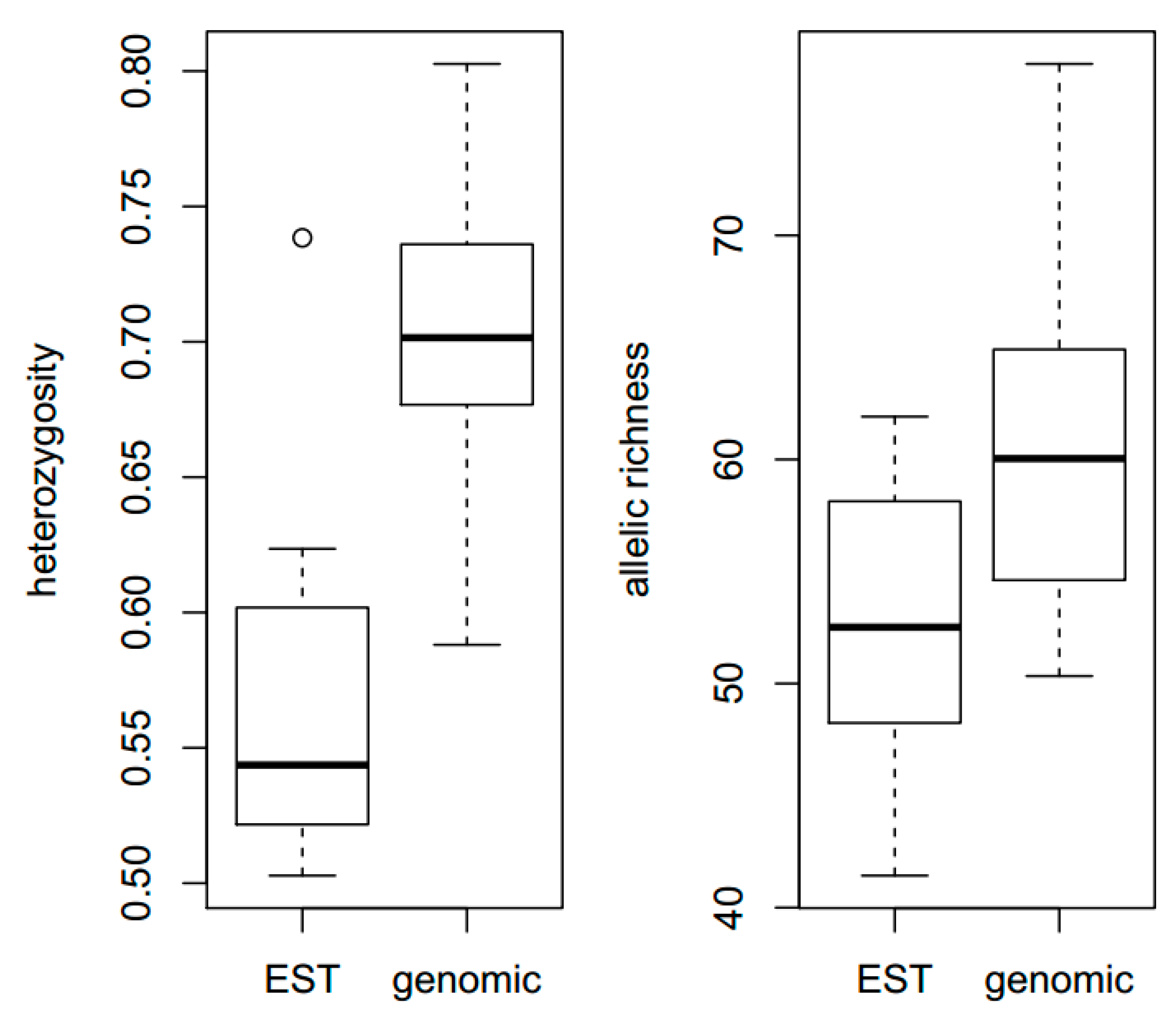
References
- Guerrant, E.O.; Havens, K.; Vitt, P. Sampling for Effective Ex Situ Plant Conservation. Int. J. Plant Sci. 2014, 175, 11–20. [Google Scholar] [CrossRef]
- Namoff, S.; Husby, C.E.; Francisco-Ortega, J.; Noblick, L.R.; Lewis, C.E.; Griffith, M.P. How well does a botanical garden collection of a rare palm capture the genetic variation in a wild population? Biol. Conserv. 2010, 143, 1110–1117. [Google Scholar] [CrossRef]
- Whitlock, R.; Hipperson, H.; Thompson, D.B.A.; Butlin, R.K.; Burke, T. Consequences of in-situ strategies for the conservation of plant genetic diversity. Biol. Conserv. 2016, 203, 134–142. [Google Scholar] [CrossRef]
- Frankham, R. Relationship of Genetic Variation to population size in wildlife. Conserv. Biol. 1996, 10, 1500–1508. [Google Scholar] [CrossRef]
- Pelletier, T.A.; Carstens, B.C. Geographical range size and latitude predict population genetic structure in a global survey. Biol. Lett. 2018, 14, 20170566. [Google Scholar] [CrossRef]
- Hamrick, J.L.; Godt, M.J.W. Effects of life history traits on genetic diversity in plant species. Philos. Trans. R. Soc. Lond. B Biol. Sci. 1996, 351, 1291–1298. [Google Scholar] [CrossRef]
- Frankham, R.; Bradshaw, C.J.A.; Brook, B.W. Genetics in conservation management: Revised recommendations for the 50/500 rules, Red List criteria and population viability analyses. Biol. Conserv. 2014, 170, 56–63. [Google Scholar] [CrossRef]
- Kremer, A.; Potts, B.M.; Delzon, S. Genetic divergence in forest trees: Understanding the consequences of climate change. Funct. Ecol. 2014, 28, 22–36. [Google Scholar] [CrossRef]
- Sork, V.L.; Davis, F.W.; Westfall, R.; Flint, A.; Ikegami, M.; Wang, H.; Grivet, D. Gene movement and genetic association with regional climate gradients in California valley oak (Quercus lobata Née) in the face of climate change. Mol. Ecol. 2010, 19, 3806–3823. [Google Scholar] [CrossRef]
- Eckert, C.G.; Samis, K.E.; Lougheed, S.C. Genetic variation across species’ geographical ranges: The central–marginal hypothesis and beyond. Mol. Ecol. 2008, 17, 1170–1188. [Google Scholar] [CrossRef]
- Hoban, S. New guidance for ex situ gene conservation: Sampling realistic population systems and accounting for collection attrition. Biol. Conserv. 2019, 235, 199–208. [Google Scholar] [CrossRef]
- Hoban, S.; Schlarbaum, S. Optimal sampling of seeds from plant populations for ex-situ conservation of genetic biodiversity, considering realistic population structure. Biol. Conserv. 2014, 177, 90–99. [Google Scholar] [CrossRef]
- Hoban, S.; Callicrate, T.; Clark, J.; Deans, S.; Dosmann, M.; Fant, J.; Gailing, O.; Havens, K.; Hipp, A.L.; Kadav, P.; et al. Taxonomic similarity does not predict necessary sample size for ex situ conservation: A comparison among five genera. Proc. R. Soc. B 2020, 287, 20200102. [Google Scholar] [CrossRef] [PubMed]
- Jackson, P.W.; Kennedy, K. The Global Strategy for Plant Conservation: A challenge and opportunity for the international community. Trends Plant Sci. 2009, 14, 578–580. [Google Scholar] [CrossRef]
- Cavender, N.; Westwood, M.; Bechtoldt, C.; Donnelly, G.; Oldfield, S.; Gardner, M.; Rae, D.; McNamara, W. Strengthening the conservation value of ex situ tree collections. Oryx 2015, 49, 416–424. [Google Scholar] [CrossRef]
- Westwood, M.; Cavender, N.; Meyer, A.; Smith, P. Botanic garden solutions to the plant extinction crisis. Plants People Planet 2021, 3, 22–32. [Google Scholar] [CrossRef]
- Pence, V.C. In Vitro methods and the challenge of exceptional species for target 8 of the global strategy for plant conservation1. Ann. Mo. Bot. Gard. 2013, 99, 214–220. [Google Scholar] [CrossRef]
- Carrero, C.; Jerome, D.; Beckman, E.; Byrne, A.; Coombes, A.J.; Deng, M.; González-Rodríguez, A.; Hoang, V.S.; Khoo, E.; Nguyen, N.; et al. The Red List of Oaks 2020; The Morton Arboretum: Lisle, IL, USA, 2020. [Google Scholar]
- Jerome, D.; Beckman, E.; Kenny, L.; Wenzell, K.; Kua, C.-S.; Westwood, M. US Oaks; The Morton Arboretum: Lisle, IL, USA, 2017. [Google Scholar]
- Connor, K.F. Update on oak seed quality research: Hardwood recalcitrant seeds. National Proceedings, forestry and conser-vation nursery associations—2003. Ogden (UT): USDA Forest Service. Rocky Mt. Res. Stn. Proc. RMRS-P-33 2004, 111–116. [Google Scholar]
- Kramer, A.T.; Pence, V. The challenges of ex situ conservation for threatened oaks. Intl. Oaks 2012, 23, 91–108. [Google Scholar]
- Fant, J.B.; Havens, K.; Kramer, A.T.; Walsh, S.K.; Callicrate, T.; Lacy, R.C.; Maunder, M.; Meyer, A.H.; Smith, P.P. What to do when we cant bank on seeds: What botanic gardens can learn from the zoo community about conserving plants in living collections. Am. J. Bot. 2016, 103, 1541–1543. [Google Scholar] [CrossRef]
- Wood, J.; Ballou, J.D.; Callicrate, T.; Fant, J.B.; Griffith, M.P.; Kramer, A.T.; Lacy, R.C.; Meyer, A.; Sullivan, S.; Traylor-Holzer, K.; et al. Applying the zoo model to conservation of threatened exceptional plant species. Conserv. Biol. 2020, 34, 1416–1425. [Google Scholar] [CrossRef] [PubMed]
- Tallamy, D.W.; Shropshire, K.J. Ranking Lepidopteran use of native versus introduced plants. Conserv. Biol. 2009, 23, 941–947. [Google Scholar] [CrossRef]
- Varela, M.C.; Eriksson, G. Multipurpose gene conservation in Quercus suber—A Portuguese example. Silvae Genet. 1995, 44, 28–36. [Google Scholar]
- Leroy, T.; Plomion, C.; Kremer, A. Oak symbolism in the light of genomics. New Phytol. 2019, 226, 1012–1017. [Google Scholar] [CrossRef] [PubMed]
- Beckman, E. Conservation Gap Analysis of Native US Oaks; Morton Arboretum: Lisle, IL, USA, 2019. [Google Scholar]
- McShea, W.J.; Healy, W.M.; Devers, P.; Fearer, T.; Koch, F.H.; Stauffer, D.; Waldon, J. Forestry matters: Decline of oaks will impact wildlife in hardwood forests. J. Wildl. Manag. 2007, 71, 1717–1728. [Google Scholar] [CrossRef]
- Cavender-Bares, J. Diversity, distribution and ecosystem services of the North American oaks. Int. Oaks 2016, 27, 37–48. [Google Scholar]
- Logan, W.B. Oak: Frame of Civilization; W.W. Norton & Company, Inc.: New York, NY, USA, 2005. [Google Scholar]
- Cavender-Bares, J. Diversification, adaptation, and community assembly of the American oaks (Quercus), a model clade for integrating ecology and evolution. New Phytol. 2019, 221, 669–692. [Google Scholar] [CrossRef]
- Leroy, T.; Louvet, J.; Lalanne, C.; Le Provost, G.; Labadie, K.; Aury, J.; Delzon, S.; Plomion, C.; Kremer, A. Adaptive introgression as a driver of local adaptation to climate in European white oaks. New Phytol. 2020, 226, 1171–1182. [Google Scholar] [CrossRef]
- Synge, H. The Biological Aspects of Rare Plant Conservation Edited by Hugh Synge, Seven forms of rarity; John Wiley & Sons Ltd.: New York, NY, USA, 1981; pp. 205–217. [Google Scholar]
- Beckman, E.; Hoban, S.; Spence, E.; Meyer, A.; Westwood, M. Species Profile: Quercus boyntonii Beadle; Conservation Gap Analysis of Native U.S: Thousand Oaks, CA, USA, 2019; pp. 74–79. [Google Scholar]
- Toppila, R. Ex Situ Conservation of Oak (Quercus L.) in Botanic Gardens: A North American Perspective. Ph.D. Thesis, University of Delewarw, Newark, DE, USA, 2012. [Google Scholar]
- Chabane, K.; Ablett, G.A.; Cordeiro, G.M.; Valkoun, J.; Henry, R.J. EST versus genomic derived microsatellite markers for genotyping wild and cultivated barley. Genet. Resour. Crop. Evol. 2005, 52, 903–909. [Google Scholar] [CrossRef]
- Lobdell, M.S.; Thompson, P.G. Ex-situ Conservation of Quercus Oglethorpensis in Living Collections of Arboreta and Botanical Gardens. In Gene Conservation of Tree Species—Banking on the Future. Proceedings of a Workshop; Sniezko, R.A., Man, G., Hipkins, V., Woeste, K., Gwaze, D., Kliejunas, J.T., McTeague, B.A., Eds.; Tech. Cords. Gen. Tech. Rep. PNW-GTR-963; Department of Agriculture, Forest Service Pacific Northwest Research Station: Portland, OR, USA, 2017; Volume 963, pp. 144–153. [Google Scholar]
- Kamvar, Z.N.; Tabima, J.F.; Grünwald, N.J. Poppr: An R package for genetic analysis of populations with clonal, partially clonal, and/or sexual reproduction. PeerJ 2014, 2, e281. [Google Scholar] [CrossRef]
- Goudet, J. Hierfstat, a package for r to compute and test hierarchical F-statistics. Mol. Ecol. Notes 2005, 5, 184–186. [Google Scholar] [CrossRef]
- Keenan, K.; McGinnity, P.; Cross, T.F.; Crozier, W.W.; Prodöhl, P.A. diveRsity: An R package for the estimation and explo-ration of population genetics parameters and their associated errors. Methods Ecol. Evol. 2013, 4, 782–788. [Google Scholar] [CrossRef]
- Kraemer, P.; Gerlach, G. Demerelate: Calculating interindividual relatedness for kinship analysis based on codominant diploid genetic markers using R. Mol. Ecol. Resour. 2017, 17, 1371–1377. [Google Scholar] [CrossRef]
- Blouin, M.S.; Parsons, M.; Lacaille, V.; Lotz, S. Use of microsatellite loci to classify individuals by relatedness. Mol. Ecol. 1996, 5, 393–401. [Google Scholar] [CrossRef] [PubMed]
- Ritland, K. Estimators for pairwise relatedness and individual inbreeding coefficients. Genet. Res. 1996, 67, 175–185. [Google Scholar] [CrossRef]
- Wang, J. An estimator for pairwise relatedness using molecular markers. Genetics 2002, 160, 1203–1215. [Google Scholar] [CrossRef] [PubMed]
- Piry, S.; Luikart, G.; Cornuet, J.-M. Bottleneck: A program for detecting recent effective population size reductions from allele data frequencies. J. Hered. 1999, 90, 502–503. [Google Scholar] [CrossRef]
- Fick, S.E.; Hijmans, R.J. WorldClim 2: New 1-km spatial resolution climate surfaces for global land areas. Int. J. Climatol. 2017, 37, 4302–4315. [Google Scholar] [CrossRef]
- R Core Team. R: A Language and Environment for Statistical Computing; R Core Team: Vienna, Austria, 2020. [Google Scholar]
- Petit, R.J.; Hampe, A. Some Evolutionary Consequences of Being a Tree. Annu. Rev. Ecol. Evol. Syst. 2006, 37, 187–214. [Google Scholar] [CrossRef]
- Wojacki, J.; Eusemann, P.; Ahnert, D.; Pakull, B.; Liesebach, H. Genetic diversity in seeds produced in artificial Douglas-fir (Pseudotsuga menziesii) stands of different size. For. Ecol. Manag. 2019, 438, 18–24. [Google Scholar] [CrossRef]
- Marshall, D.R.; Brown, A.H.D. Optimum Sampling Strategies in Genetic Conservation. In Crop Genetic Resources for Today and Tomorrow. Cambridge University Press: Cambridge, UK, 1975; pp. 53–80. [Google Scholar]
- Hoban, S.; Strand, A. Ex situ seed collections will benefit from considering spatial sampling design and species’ reproductive biology. Biol. Conserv. 2015, 187, 182–191. [Google Scholar] [CrossRef]
- Backs, J.R.; Terry, M.; Ashley, M.V. Using genetic analysis to evaluate hybridization as a conservation concern for the threatened species Quercus hinckleyi C.H. Muller (Fagaceae). Int. J. Plant Sci. 2016, 177, 122–131. [Google Scholar] [CrossRef]
- Ashley, M.V.; Backs, J.R.; Kindsvater, L.; Abraham, S.T. Genetic variation and structure in an endemic island oak, Quercus tomentella, and mainland Canyon oak, Quercus chrysolepis. Int. J. Plant Sci. 2018, 179, 151–161. [Google Scholar] [CrossRef]
- Hoban, S.M.; Gaggiotti, O.E.; Bertorelle, G. The number of markers and samples needed for detecting bottlenecks under realistic scenarios, with and without recovery: A simulation-based study. Mol. Ecol. 2013, 22, 3444–3450. [Google Scholar] [CrossRef] [PubMed]
- Hoban, S.M.; Borkowski, D.S.; Brosi, S.L.; McCLEARY, T.S.; Thompson, L.M.; McLACHLAN, J.S.; Pereira, M.A.; Schlarbaum, S.E.; Romero-Severson, J. Range-wide distribution of genetic diversity in the North American tree Juglans cinerea: A prod-uct of range shifts, not ecological marginality or recent population decline. Mol. Ecol. 2010, 19, 4876–4891. [Google Scholar] [CrossRef]
- Schnabel, A.; Hamrick, J.L. Comparative Analysis of Population Genetic Structure in Quercus macrocarpa and Q. gambelii (Fagaceae). Syst. Bot. 1990, 15, 240. [Google Scholar] [CrossRef]
- Franklin, I.R.; Frankham, R. How large must populations be to retain evolutionary potential? Anim. Conserv. 1998, 1, 69–70. [Google Scholar] [CrossRef]
- Hastings, K.; Frissell, C.A.; Allendorf, F.W. Naturally isolated coastal cutthroat trout populations provide empirical support for the 50/500 rule. In Proceedings of the 2005 Coastal Cutthroat Trout Symposium, Port Townsend, Washington, DC, USA, 29 September–1 October 2005; p. 121. [Google Scholar]
- Stein, J.D. Field Guide to Native Oak Species of Eastern North America; U.S. Forest Service, Forest Health Technology Enterprise Team: Morgantown, WV, USA, 2001. [Google Scholar]
- Koenig, W.D.; Ashley, M.V. Is pollen limited? The answer is blowin’ in the wind. Trends Ecol. Evol. 2003, 18, 157–159. [Google Scholar] [CrossRef]
- Ortego, J.; Riordan, E.C.; Gugger, P.F.; Sork, V.L. Influence of environmental heterogeneity on genetic diversity and structure in an endemic southern Californian oak. Mol. Ecol. 2012, 21, 3210–3223. [Google Scholar] [CrossRef]
- Lira-Noriega, A.; Manthey, J.D. Relationship of genetic diversity and niche centrality: A survey and analysis. Evolution 2014, 68, 1082–1093. [Google Scholar] [CrossRef]
- Diniz-Filho, J.A.F.; Rodrigues, H.; Telles, M.P.D.C.; De Oliveira, G.; Terribile, L.C.; Soares, T.N.; Nabout, J.C. Correlation between genetic diversity and environmental suitability: Taking uncertainty from ecological niche models into account. Mol. Ecol. Resour. 2015, 15, 1059–1066. [Google Scholar] [CrossRef]
- Christe, C.; Kozlowski, G.; Frey, D.; Fazan, L.; Bétrisey, S.; Pirintsos, S.; Gratzfeld, J.; Naciri, Y. Do living ex situ collections capture the genetic variation of wild populations? A molecular analysis of two relict tree species, Zelkova abelica and Zelkova carpinifolia. Biodivers. Conserv. 2014, 23, 2945–2959. [Google Scholar] [CrossRef]
- Sharrock, S.; Oldfield, S.; Wilson, O. Plant Conservation Report 2014: A Review of Progress towards the Global Strategy for Plant Conservation 2011-2020. CBD Technical Series; Convention on Biological Diversity: Montreal, QC, Canada, 2014. [Google Scholar]
- Hurka, H. Conservation Genetics and the Role of Botanical Gardens. In Conservation Genetics; Loeschcke, V., Jain, S.K., Tomiuk, J., Eds.; Birkhäuser Basel: Basel, Switzerland, 1994; pp. 371–380. ISBN 9783034885102. [Google Scholar]
- Maunder, M.; Higgens, S.; Culham, A. The effectiveness of botanic garden collections in supporting plant conservation: A European case study. Biodivers. Conserv. 2001, 10, 383–401. [Google Scholar] [CrossRef]
- Griffith, M.P.; Calonje, M.; Meerow, A.W.; Tut, F.; Kramer, A.T.; Hird, A.; Magellan, T.M.; Husby, C.E. Can a botanic garden Cycad collection capture the genetic diversity in a wild population? Int. J. Plant Sci. 2015, 176, 1–10. [Google Scholar] [CrossRef]
- Sharrock, S.; Jones, M. Saving Europe’s threatened flora: Progress towards GSPC Target 8 in Europe. Biodivers. Conserv. 2010, 20, 325–333. [Google Scholar] [CrossRef]
- Hoban, S.; Volk, G.; Routson, K.J.; Walters, C.; Richards, C. Sampling Wild Species to Conserve Genetic Diversity. In North American Crop Wild Relatives; Springer: Berlin/Heidelberg, Germany, 2018; pp. 209–228. [Google Scholar]
- Hodel, R.G.J.; Segovia-Salcedo, M.C.; Landis, J.B.; Crowl, A.A.; Sun, M.; Liu, X.; Gitzendanner, M.A.; Douglas, N.A.; Germain-Aubrey, C.C.; Chen, S.; et al. The Report of my death was an exaggeration: A review for researchers using microsatellites in the 21st century. Appl. Plant Sci. 2016, 4, 1600025. [Google Scholar] [CrossRef]
- Angeloni, F.; Wagemaker, N.; Vergeer, P.; Ouborg, J. Genomic toolboxes for conservation biologists. Evol. Appl. 2011, 5, 130–143. [Google Scholar] [CrossRef]
- Petit, R.J.; Bodénès, C.; Ducousso, A.; Roussel, G.; Kremer, A. Hybridization as a mechanism of invasion in oaks. New Phytol. 2004, 161, 151–164. [Google Scholar] [CrossRef]
- Petit, R.J.; Latouche-Hallé, C.; Pemonge, M.-H.; Kremer, A. Chloroplast DNA variation of oaks in France and the influence of forest fragmentation on genetic diversity. For. Ecol. Manag. 2002, 156, 115–129. [Google Scholar] [CrossRef]
- Harada, K.; Dwiyanti, F.; Liu, H.-Z.; Takeichi, Y.; Nakatani, N.; Kamiya, K. Genetic variation and structure of Ubame oak, Quercus phillyraeoides, in Japan revealed by chloroplast DNA and nuclear microsatellite markers. Genes Genet. Syst. 2018, 93, 37–50. [Google Scholar] [CrossRef]
- Borkowski, D.S.; Hoban, S.M.; Chatwin, W.; Romero-Severson, J. Rangewide population differentiation and population substructure in Quercus rubra L. Tree Genet. Genomes 2017, 13, 67. [Google Scholar] [CrossRef]
- Backs, J.R.; Ashley, M.V. Evolutionary history and gene flow of an endemic island oak: Quercus pacifica. Am. J. Bot. 2016, 103, 2115–2125. [Google Scholar] [CrossRef] [PubMed]
- Ashley, M.V.; Abraham, S.T.; Backs, J.R.; Koenig, W.D. Landscape genetics and population structure in Valley Oak (Quercus lobata Née). Am. J. Bot. 2015, 102, 2124–2131. [Google Scholar] [CrossRef] [PubMed]
- Craft, K.J.; Ashley, M.V. Landscape genetic structure of bur oak (Quercus macrocarpa) savannas in Illinois. For. Ecol. Manag. 2007, 239, 13–20. [Google Scholar] [CrossRef]
- Dow, B.D.; Ashley, M.V. Microsatellite analysis of seed dispersal and parentage of saplings in bur oak, Quercus macrocarpa. Mol. Ecol. 1996, 5, 615–627. [Google Scholar] [CrossRef]
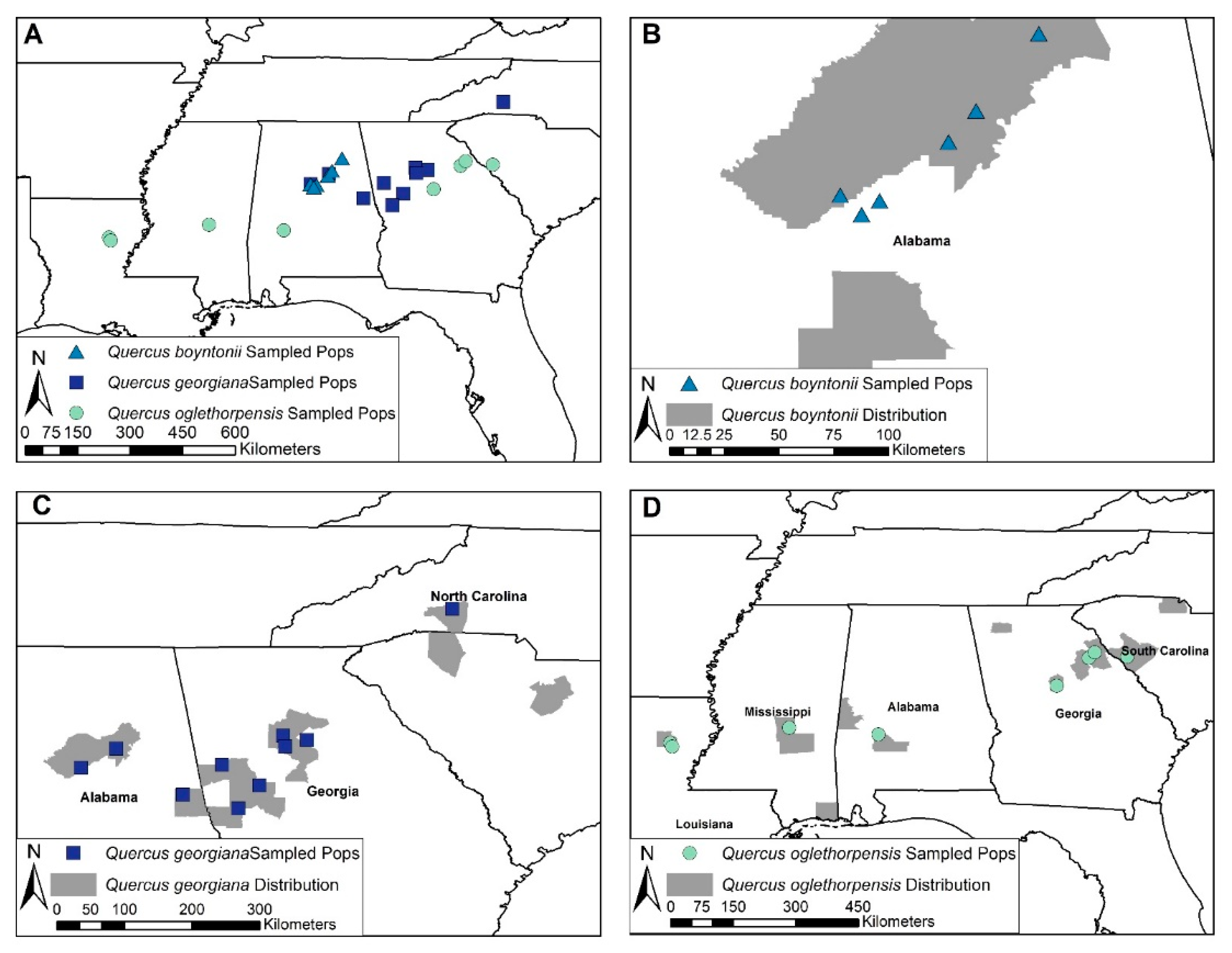
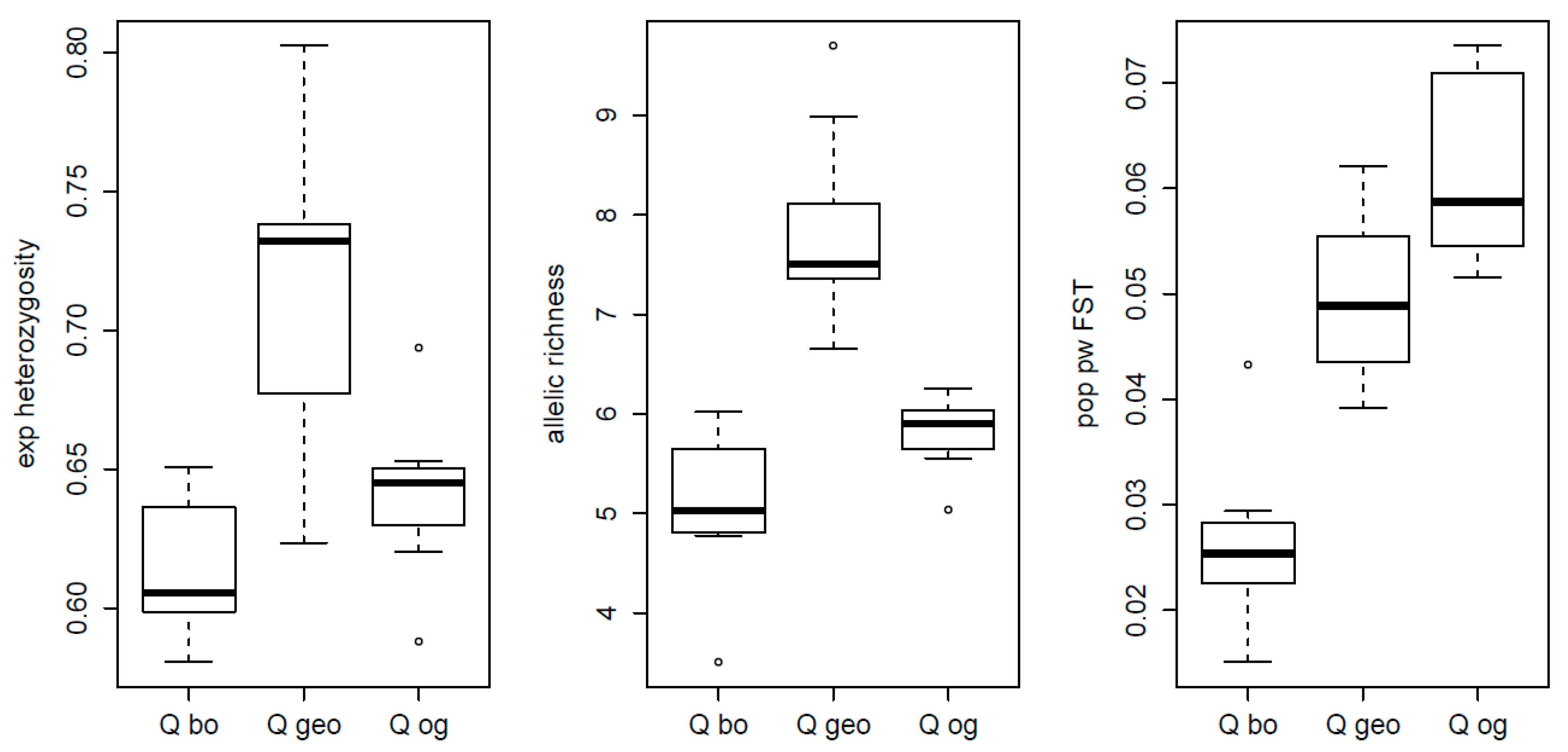
| Species | IUCN Listing; Habitat and Geographic Range | AOO (km2) | EOO (km2) | Number of Adult Trees | Population Trend |
|---|---|---|---|---|---|
| Quercus boyntonii | Critically Endangered; restricted occurrence in Alabama, restricted to sandstone outcrops and glades, and steep dry hillsides | 24 | 4157 | 50–200 | Stable |
| Quercus georgiana | Endangered; restricted to isolated granite outcrops and flat-rocks in the Piedmont Plateau of the Southeastern United States. | 72–272 | 16,570–21,600 | Unknown | Decreasing |
| Quercus oglethorpensis | Endangered; disjunct distribution; small clusters of localities in Louisiana, Mississippi, and Alabama, and a more extensive distribution from Northeast Georgia into South Carolina | 180–3000 | 130,000 | 1000 | Decreasing |
| Species | Pop Name | State | N Samples Genotyped (Unique MLG) | Hexp | Ar | Mean Pairwise FST | Rel | Pop Size est. |
|---|---|---|---|---|---|---|---|---|
| Q. boyntonii | IMLS032 | AL | 14 (12) | 0.581 | 5.02 | 0.023 | −0.014 | 20 |
| IMLS048 | AL | 17 (15) | 0.605 | 5.45 | 0.029 | 0.234 | 30 | |
| IMLS068 | AL | 22 (22) | 0.605 | 4.84 | 0.027 | 0.024 | 25 | |
| IMLS138 | AL | 12 (11) | 0.593 | 3.51 | 0.043 | 0.013 | 5 | |
| IMLS280 | AL | 83 (76) | 0.642 | 5.85 | 0.015 | 0.05 | 165 | |
| IMLS244 | AL | 60 (60) | 0.63 | 4.78 | 0.023 | 0.134 | 150 | |
| IMLS307 | AL | 30 (30) | 0.651 | 6.02 | 0.025 | −0.013 | 70 | |
| AVERAGE | -- | 34 (32) | 0.615 | 5.07 | 0.026 | 0.061 | 66 | |
| Q. georgiana | MR24 | AL | 24 | 0.738 | 7.355 | 0.051 | 0.031 | 24 |
| EDEN32 | AL | 25 | 0.624 | 7.739 | 0.056 | −0.056 | 50 | |
| Pen32 | AL | 26 | 0.736 | 7.506 | 0.062 | 0.156 | 50 | |
| CB32 | GA | 24 | 0.709 | 6.827 | 0.049 | 0.075 | 100 | |
| DK32 | GA | 25 | 0.677 | 7.503 | 0.046 | 0.123 | 100 | |
| CR31 | GA | 24 | 0.677 | 6.656 | 0.056 | 0.069 | 50 | |
| SM32 | GA | 26 | 0.732 | 8.114 | 0.042 | 0.167 | 100 | |
| am29 | GA | 25 | 0.803 | 9.706 | 0.039 | 0.131 | 100 | |
| WGHerb | GA | 25 | 0.769 | 8.993 | 0.044 | 0.415 | 30 | |
| COP-9 | NC | 26 | 0.588 | 5.03 | 0.074 | −0.043 | 200 | |
| AVERAGE | -- | 25 | 0.705 | 7.54 | 0.052 | 0.107 | 80 | |
| Q. oglethorpensis | RMS-9 | LA | 14 | 0.645 | 5.9 | 0.069 | 0.017 | 200 |
| BIE-3-7 | MS | 33 | 0.694 | 6.03 | 0.052 | −0.025 | 50 | |
| CAT-9 | AL | 27 | 0.639 | 6.25 | 0.054 | 0.075 | 60 | |
| MOT-9 | GA | 31 | 0.653 | 5.56 | 0.073 | 0.172 | 500 | |
| BUF-9 | GA | 29 | 0.62 | 5.75 | 0.059 | 0.008 | 50 | |
| SUM-9 | SC | 28 | 0.648 | 6.06 | 0.055 | 0.028 | 40 | |
| AVERAGE | -- | 27 | 0.65 | 5.93 | 0.06 | 0.046 | 150 |
| Allele Frequency Category (%) | |||||||
|---|---|---|---|---|---|---|---|
| Species | N Plants Ex Situ | Geographic Range Size | All | Very Common | Common | Low Frequency | Rare |
| Q. oglethorpensis | 145 | large | 78 (94) | 100 | 100 | 97 | 37 (67) |
| Q. georgiana (EST-SSR) | 36 | medium | 61 (68) | 100 | 85 | 51 | 33 (33) |
| Q. georgiana (nSSR) | 36 | medium | 69 (76) | 100 | 100 | 75 | 35 (41) |
| Q. boyntonii | 77 | small | 60 (70) | 100 | 100 | 66 | 32 (29) |
Publisher’s Note: MDPI stays neutral with regard to jurisdictional claims in published maps and institutional affiliations. |
© 2021 by the authors. Licensee MDPI, Basel, Switzerland. This article is an open access article distributed under the terms and conditions of the Creative Commons Attribution (CC BY) license (https://creativecommons.org/licenses/by/4.0/).
Share and Cite
Spence, E.S.; Fant, J.B.; Gailing, O.; Griffith, M.P.; Havens, K.; Hipp, A.L.; Kadav, P.; Kramer, A.; Thompson, P.; Toppila, R.; et al. Comparing Genetic Diversity in Three Threatened Oaks. Forests 2021, 12, 561. https://doi.org/10.3390/f12050561
Spence ES, Fant JB, Gailing O, Griffith MP, Havens K, Hipp AL, Kadav P, Kramer A, Thompson P, Toppila R, et al. Comparing Genetic Diversity in Three Threatened Oaks. Forests. 2021; 12(5):561. https://doi.org/10.3390/f12050561
Chicago/Turabian StyleSpence, Emma Suzuki, Jeremie B. Fant, Oliver Gailing, M. Patrick Griffith, Kayri Havens, Andrew L. Hipp, Priyanka Kadav, Andrea Kramer, Patrick Thompson, Raakel Toppila, and et al. 2021. "Comparing Genetic Diversity in Three Threatened Oaks" Forests 12, no. 5: 561. https://doi.org/10.3390/f12050561
APA StyleSpence, E. S., Fant, J. B., Gailing, O., Griffith, M. P., Havens, K., Hipp, A. L., Kadav, P., Kramer, A., Thompson, P., Toppila, R., Westwood, M., Wood, J., Zumwalde, B. A., & Hoban, S. (2021). Comparing Genetic Diversity in Three Threatened Oaks. Forests, 12(5), 561. https://doi.org/10.3390/f12050561








